How AI and ML Transform Call Center Automation Today
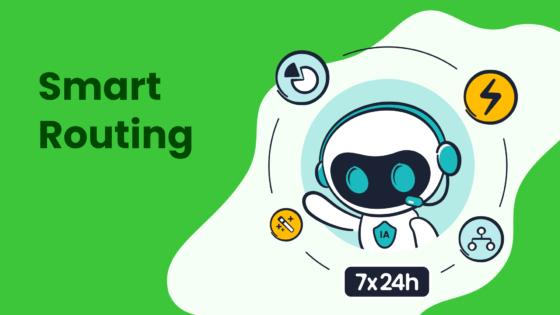
AI and machine learning are transforming the call center by making automation smarter and more effective. The global call center AI market reached $3.23 billion in 2024 and could climb to $25.84 billion by 2034 (source). Companies use artificial intelligence to automate call center tasks like answering questions, routing calls, and analyzing conversations.
- AI-powered automation now handles booking requests in airlines, technical support in software, and banking transactions.
- AI chatbots and virtual agents deliver 24/7 support, improving customer experience and reducing wait times.
- AI tools predict needs, personalize service, and monitor quality for better agent performance.
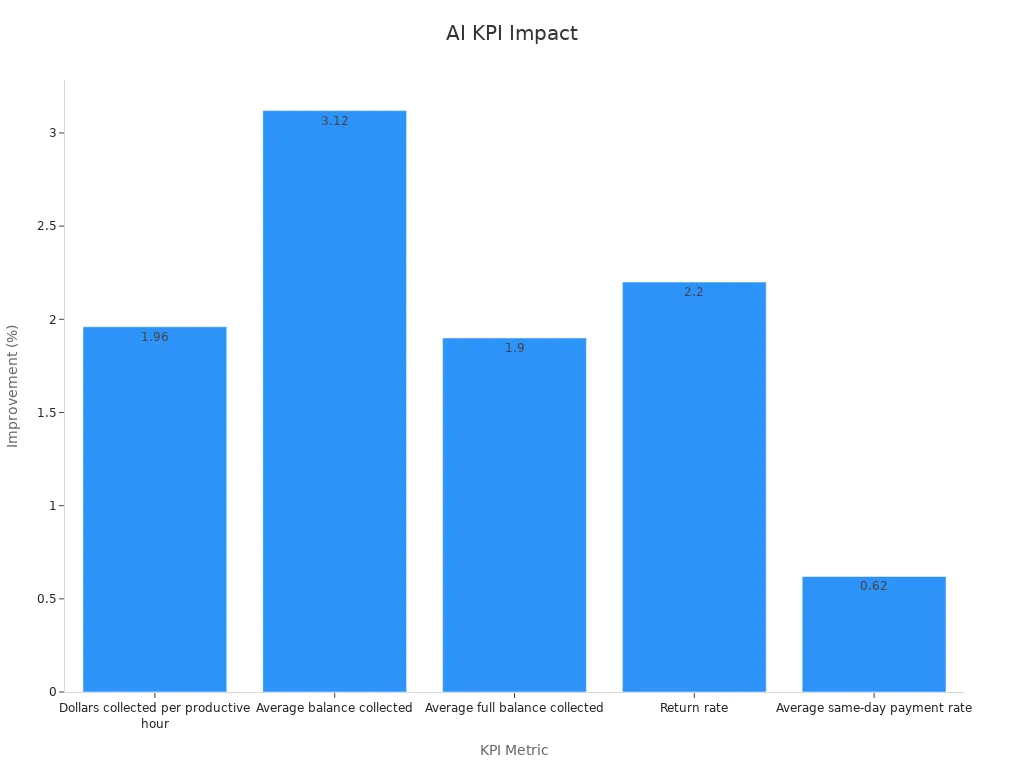
Sobot AI helps automate call center operations for many industries, making customer interactions faster and more accurate. Businesses using call center automation reduce costs and increase efficiency. As more companies automate call center functions, they see higher satisfaction and better results.
AI and ML in Call Center Automation
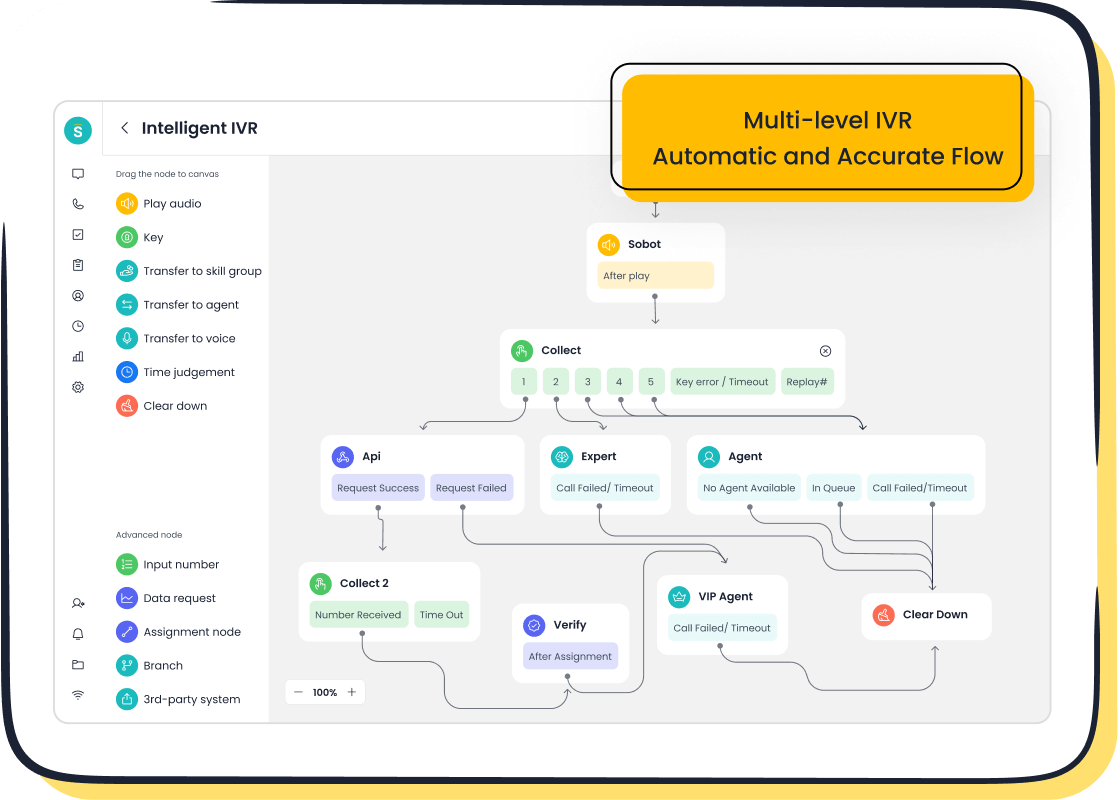
What Is Call Center AI?
Call center AI uses artificial intelligence and machine learning to automate and improve customer service operations. These technologies help call centers handle large volumes of calls, messages, and requests. AI systems can answer questions, route calls, and analyze conversations in real time. Machine learning in call centers allows systems to learn from past interactions and improve over time. Many call centers now use conversational AI, such as chatbots and voice assistants, to provide 24/7 support. Industry data shows that 45% of customer support teams use AI, and 83% of executives make it a top priority. Companies like Capital One have reduced call transfers by 50% with AI, while Bank of America uses AI to prioritize urgent calls. AI-driven predictive analytics can increase customer retention by 20%, and generative AI assistants boost agent productivity by 14%.
Sobot’s Approach
Sobot delivers advanced call center automation by combining AI, machine learning, and conversational AI in its solutions. Sobot’s platform supports omnichannel communication, including voice, chat, email, and social media. The system uses intelligent IVR, smart call routing, and AI-powered voicebots to automate routine tasks and improve customer experience. Sobot’s unified workspace helps agents manage calls and customer data efficiently. Real-time analytics and monitoring tools allow businesses to track performance and make data-driven decisions. Sobot’s cloud-based call center technology ensures high uptime and easy integration with existing systems. This approach helps companies reduce costs, increase efficiency, and deliver better service.
Industry Standards
The global call center AI market was valued at $2.1 billion in 2024 and is expected to grow at a CAGR of 18.9% through 2034 (source).
Key trends include:
- Over 71% of the market comes from AI solution platforms.
- The U.S. holds 76% of the market share.
- Technologies like machine learning, NLP, speech recognition, and conversational AI drive growth.
- Many call centers now use cloud-based AI for scalability and remote work.
- Industry leaders focus on omnichannel AI platforms that connect voice, chat, email, and social media.
- AI integration aims to improve customer experience, manage high call volumes, and lower costs.
Note: A robust AI infrastructure connects CRM, IVR, VoIP, and analytics systems. This integration supports smart call routing, personalized service, and better agent performance.
Key Benefits of Contact Center Automation
Customer Experience
Call center automation brings a new level of speed and convenience to customer service. AI-powered chatbots and voicebots answer questions at any time, helping customers get quick solutions. Many customers now prefer automation for simple issues. In fact, 80% of people want to resolve problems without speaking to a live agent. Automation tools can increase customer satisfaction scores by 15-25%. Companies see a jump in first-call resolution rates from about 70% to as high as 90%. This means customers get answers faster and do not need to call back.
| Statistic Description | Percentage / Data Point |
|---|---|
| Customers wanting immediate service | 72% |
| Customers preferring AI-powered self-service for quick issue resolution | 69% |
| Customer inquiries resolved by AI without human intervention | 75% |
| Executives using AI to interact with clients | 84% |
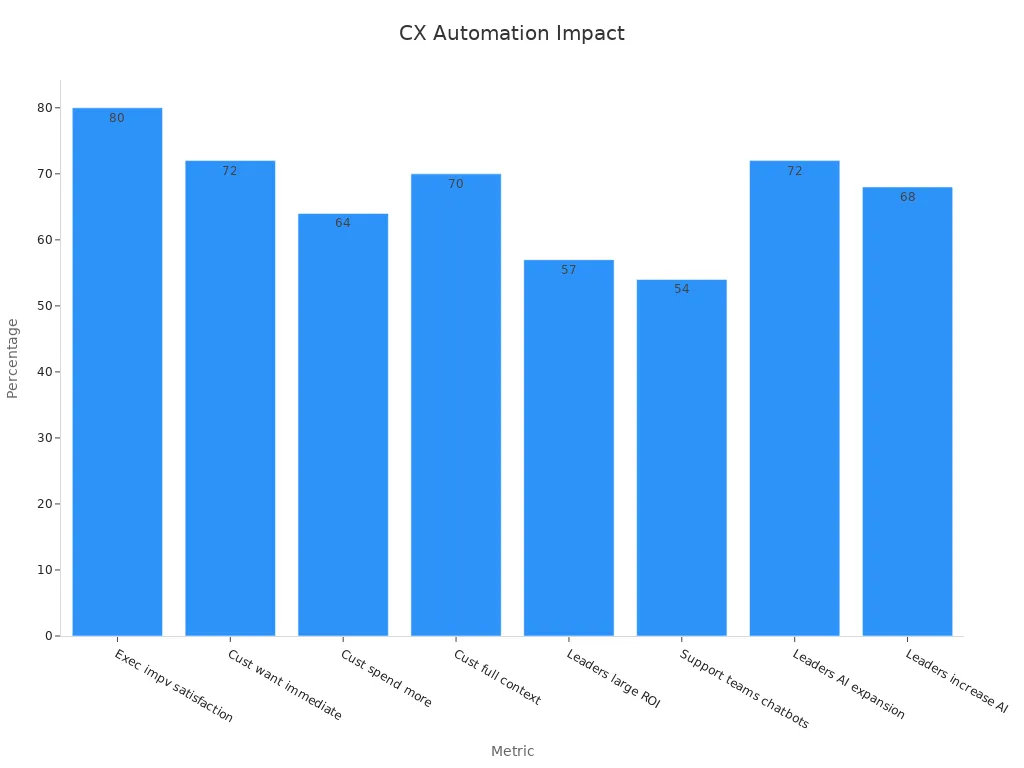
Sobot’s AI solutions help companies deliver an enhanced customer experience by providing 24/7 support and fast responses across channels.
Agent Productivity
Automation in the call center helps agents work smarter. AI handles routine tasks, so agents can focus on complex problems. This saves 20-30% of agent time, allowing them to help more customers. Real-time agent guidance tools give agents the right information during calls. These tools also track key metrics like call handle time and after-contact work. Automated quality checks and analytics help managers spot training needs and improve performance.
- AI-powered automation reduces manual work and shortens call times.
- Real-time agent guidance boosts agent confidence and accuracy.
- Self-service tools let agents focus on higher-value tasks.
Sobot’s unified workspace and real-time agent guidance features support agents with instant data and smart suggestions.
Business Outcomes
Contact center automation leads to real savings and better results for businesses. Companies save about $0.70 per customer interaction. Automation lowers costs by shifting routine tasks to digital channels. For example, American Express cut its cost per contact by 40% after using automation. Intuit reduced its cost per contact from $12 to $5 with AI-powered self-service. Comcast saved $25 million each year by reducing repeat calls.
| Metric Description | Numerical Evidence | Operational Benefit Highlighted |
|---|---|---|
| Cost savings per customer interaction | $0.70 saved on average | Reduces operational expenses |
| Improvement in first-call resolution rates | From ~70% to 85-90% | Improves efficiency and issue resolution speed |
| Reduction in manual admin work for agents | 20-30% of agent time saved | Frees agent time for higher-value tasks |
| Multi-channel support adoption | 75% of contact centers | Enables more efficient service delivery |
Sobot’s call center automation platform helps businesses improve customer service, cut costs, and boost efficiency. Real-time agent guidance and AI-driven analytics support better decision-making and long-term growth.
How to Automate Call Center Operations
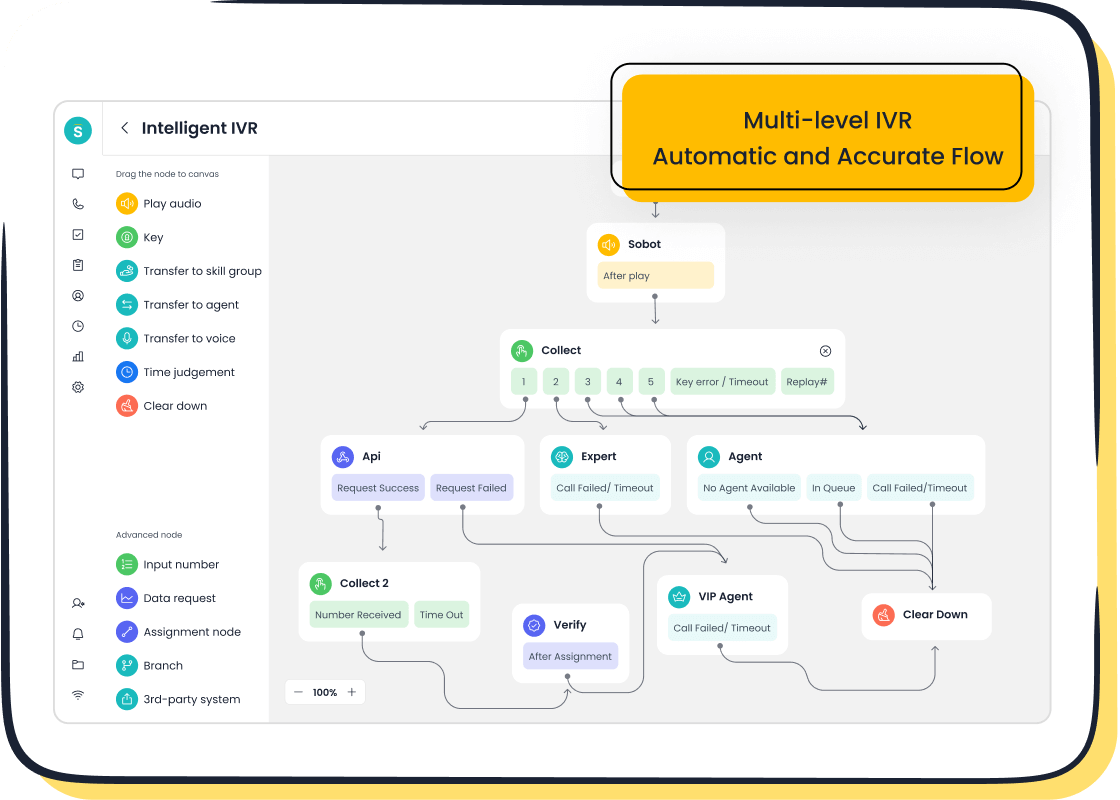
Sobot Voice/Call Center
Sobot Voice/Call Center helps businesses automate call center operations with advanced AI features. The platform offers intelligent IVR, smart call routing, and AI-powered voicebots. These tools automate repetitive tasks and allow agents to focus on complex issues. Sobot provides a unified workspace where agents can manage calls, view customer data, and track performance in real time.
Companies that automate call center processes with Sobot see clear benefits. For example, automating routine interactions can reduce cost per contact by 40-70%. Sobot’s cloud-based system ensures 99.99% uptime and supports global telephony, making it easy to scale during peak times. The platform integrates with CRM systems, so agents always have the information they need.
| Feature | Benefit |
|---|---|
| Intelligent IVR | Customizes greetings and routes calls |
| AI-powered Voicebot | Handles routine questions 24/7 |
| Unified Workspace | Centralizes customer data and call controls |
| Real-time Analytics | Tracks performance and identifies trends |
| Bulk Outbound Task | Automates follow-ups and lead assignments |
Sobot’s AI call center software helps companies improve efficiency, reduce costs, and deliver better customer experiences. Case studies show that companies using AI-driven solutions reduce average handle time by 10% and improve first call resolution rates.
Smart Routing
Smart routing uses AI to direct each call to the best available agent or team. Sobot’s smart call routing system analyzes customer needs and agent skills in real time. This reduces misrouted calls by up to 95% and lowers average handling time by about 2 minutes.
Companies that automate call center routing see measurable improvements:
- First call resolution rates increase, so customers get answers faster.
- Customer satisfaction scores rise because callers reach the right agent quickly.
- Net Promoter Scores improve, showing higher loyalty.
- Wait times drop, reducing abandoned calls.
| KPI Metric | Outcome |
|---|---|
| First Call Resolution | Higher percentage, fewer repeat calls |
| Customer Satisfaction | Improved scores and agent performance |
| Average Handling Time | Shorter calls, lower costs |
| Wait Times | Reduced, leading to happier customers |
Sobot’s AI call center software makes smart routing easy to configure. Businesses can set rules based on customer type, language, or issue. This ensures every customer connects with the right expert, improving both efficiency and satisfaction.
Self-Service Tools
Self-service tools let customers solve problems without waiting for an agent. Sobot’s AI-powered chatbots and voicebots provide 24/7 support for common questions and tasks. Predictive analytics help these tools anticipate customer needs and offer tailored solutions.
Automating self-service in the call center brings several advantages:
- Customers get instant answers, reducing response times.
- Predictive models forecast issues and suggest proactive solutions.
- Conversation intelligence analyzes calls to find common problems and improve self-service options.
- AI-powered tools can reduce call transfers by up to 90%, saving time for both customers and agents.
Tip: Measuring KPIs like average handle time and first contact resolution helps companies track the impact of self-service automation.
Sobot’s self-service tools integrate with other systems, so customers can check order status, reset passwords, or get product information anytime. This automation improves operational efficiency and boosts customer loyalty.
Call Center AI Technologies

Chatbots and Voicebots
Chatbots and voicebots play a key role in call center automation. These tools use conversational ai and machine learning to answer questions, solve problems, and guide customers. The IRS uses ai-powered chatbots and voicebots to handle millions of taxpayer interactions, which reduces employee workload. Voicebots can manage thousands of customers at once, making them ideal for industries like healthcare and banking. They help lower costs by taking care of repetitive tasks. Many customers feel less frustrated because voicebots reduce the need to repeat issues. In fact, 72% of customers report frustration when they must repeat themselves, but voicebots help solve this problem. Sobot’s intelligent virtual agents provide 24/7 support and improve customer experience by delivering fast, smooth interactions.
- Voicebots can set up payment plans and resolve 30-40% of customer queries.
- Real-time agent guidance helps agents focus on complex issues while bots handle routine tasks.
Intelligent IVR
Intelligent IVR systems use ai and automation to route calls and provide self-service options. These systems monitor and analyze call data to improve performance. Metrics like average handling time, call abandon rate, and call containment rate show how well the IVR works. High containment rates mean more customers get answers without speaking to an agent. Sobot’s call center technology includes customizable IVR menus and automated quality assurance, making navigation easy and efficient. Real-time analytics and CRM integration allow for personalized service and continuous improvement.
| Metric Name | Description | User Satisfaction Impact |
|---|---|---|
| Average Handling Time | Measures call duration in IVR | Shorter times improve experience |
| Call Containment Rate | Calls resolved in IVR without agent help | Higher rates show strong self-service |
| First Call Resolution | Issues solved in one interaction | Increases confidence and satisfaction |
Real-Time Analytics
Real-time analytics drive better decision-making in call center automation. These tools provide instant alerts on key metrics like SLA and KPI thresholds. Agents and supervisors can see live data on queue status, agent availability, and call metrics. This transparency supports automated quality assurance and real-time agent guidance. Sobot’s platform uses real-time analytics to identify trends, manage staffing, and improve customer satisfaction. For example, real-time tracking of first call resolution and call abandonment rates allows quick action to reduce wait times and improve service.
- Real-time sentiment analysis detects customer emotions for immediate response.
- Custom dashboards help focus on critical KPIs and support automation goals.
Integration
Seamless ai integration is essential for modern call center automation. Most call centers now use cloud-based ai solutions that work with legacy systems. APIs and AI-as-a-Service platforms make it easy to add new features without major changes. In 2024, 80% of call centers integrated ai technologies, and 70% of customer inquiries were managed solely by ai.
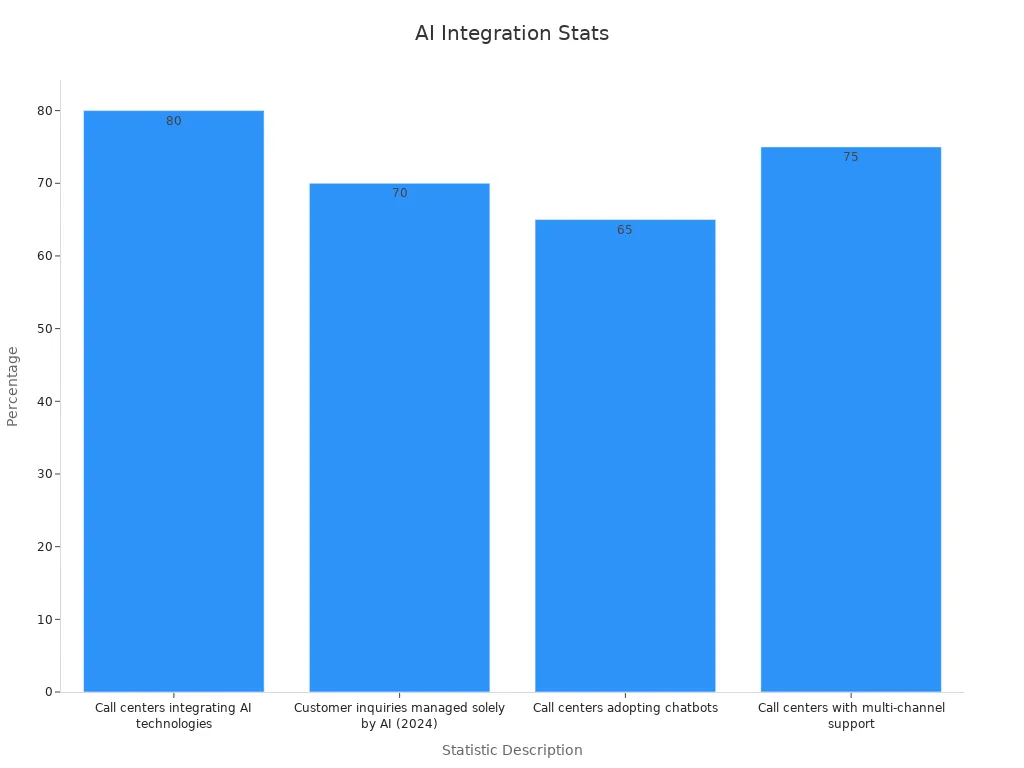
Sobot’s call center technology supports integration with CRM and other business systems, enabling multi-channel support and automated quality assurance. This approach helps large enterprises and growing businesses scale their operations efficiently.
Overcoming Challenges in Call Center Automation
Data and Integration
Call center automation depends on seamless data integration. Many call centers struggle with outdated systems and poorly integrated software. These issues slow down response times and frustrate both agents and customers. Integrating new technologies into legacy systems can cause disruptions and data inconsistencies. High IT costs and slow implementation often follow. Poor-quality data leads to longer call durations, missed opportunities, and lower customer satisfaction. Well-integrated data supports key metrics like First Call Resolution (FCR) and Customer Satisfaction (CSAT). For example, call centers with strong data integration often achieve FCR rates above 75% and CSAT scores over 85%. Sobot’s platform offers easy integration with CRM and dialer systems, helping businesses maintain smooth operations and improve call management.
Tip: Phased implementation, cloud-based platforms, and comprehensive training help reduce integration challenges.
Change Management
Adopting call center automation requires careful change management. Employees may resist new technology, which can slow adoption. Organizations track adoption rates, employee engagement, and ROI to measure success. Studies show that involving employees in decision-making increases success rates by up to 30%. Open communication and employee-led planning also boost engagement and reduce resistance. The chart below highlights the impact of different transition strategies on success rates and employee morale.
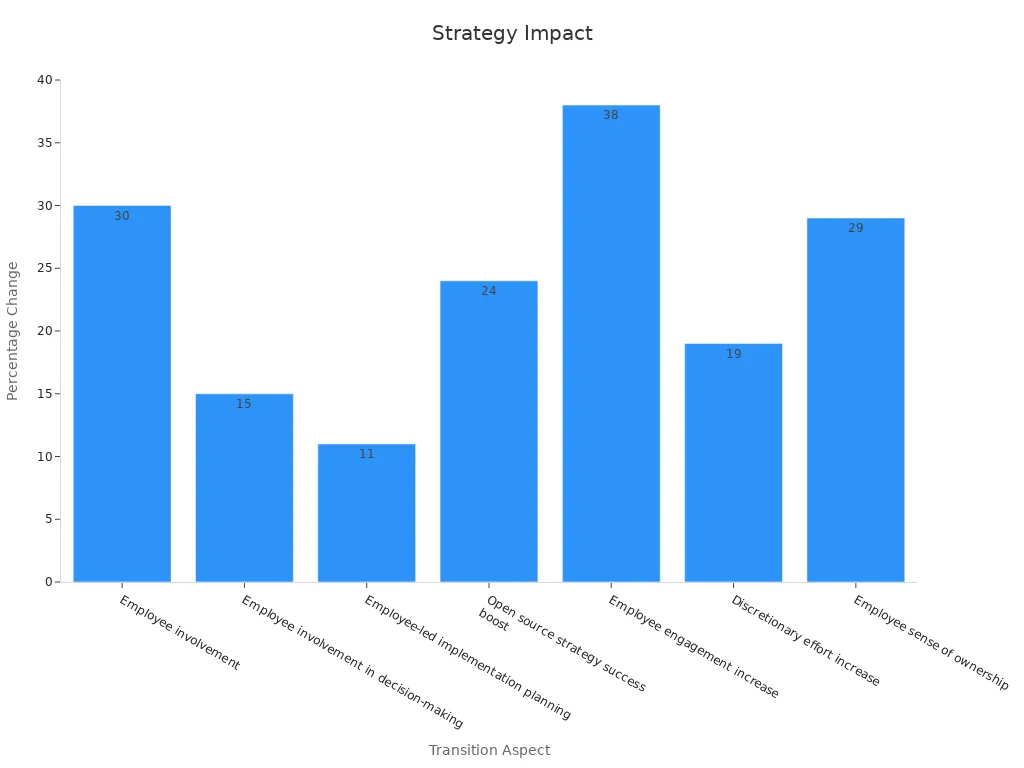
Sobot supports businesses with training and technical support, making the transition to automation smoother and more effective.
Compliance
Compliance remains a top concern in call center automation. Regulations like GDPR and PCI DSS require strict data protection and privacy controls. AI tools help call centers monitor calls for compliance risks in real time. Automated systems can detect sensitive keywords, provide instant feedback, and reduce manual audit time. A case study showed a 20% improvement in call resolution after adopting compliance-focused technology. Best practices include continuous agent training, multi-factor authentication, and robust data management. Sobot’s solutions use AI to support compliance, ensuring secure data handling and regulatory adherence while maintaining high service quality.
Sobot Success Story: Agilent
Efficiency Gains
Agilent, a leader in life sciences and diagnostics, transformed its call center operations by adopting Sobot’s ai solutions. The company faced high volumes of customer inquiries and needed a way to boost efficiency. After implementing Sobot’s omnichannel platform and ai-powered chatbot, Agilent saw a sixfold increase in efficiency. The integration of generative ai and a robust knowledge base allowed chatbots and human agents to work together smoothly. This collaboration meant that routine questions were handled quickly, freeing agents to focus on more complex issues. As a result, Agilent improved agent productivity and delivered faster responses to every customer.
Cost Reduction
Agilent’s call center also achieved significant cost savings with Sobot’s ai technology. Several strategies contributed to these results:
- AI-powered chatbots managed common inquiries, reducing the need for extra staff.
- Automated call routing replaced manual processes, cutting handling times and staffing costs.
- The system improved first call resolution and shortened average handle time, which lowered repeat calls and operational expenses.
- AI-driven insights helped identify and fix root causes of customer issues, further reducing call volumes.
These improvements led to a 25% reduction in overall costs. The scalable nature of ai allowed Agilent to handle more calls without increasing expenses, making the call center more efficient and cost-effective.
Customer Satisfaction
Agilent’s focus on customer experience paid off after adopting Sobot’s ai solutions. The call center reduced wait times and increased first contact resolution rates. Customers received accurate answers faster, which improved satisfaction scores. Nearly 90% of customers found the chatbot effective for routine questions. AI-powered routing ensured that each customer reached the right agent quickly, reducing transfers and frustration. The system also used sentiment analysis to help agents understand customer emotions, leading to more personalized and positive interactions. Agilent achieved a customer satisfaction score of 95%, showing the impact of advanced ai on service quality.
AI and ML continue to reshape the call center, driving better customer service, agent productivity, and business results. The global call center AI market, valued at over $2 billion in 2024, shows rapid growth as companies automate routine tasks and deliver 24/7 support. Real-time AI tools improve agent engagement and customer satisfaction, while cost savings reach up to 30%. Sobot’s solutions help businesses create seamless customer experiences and prepare for a future where AI handles 80% of routine inquiries.
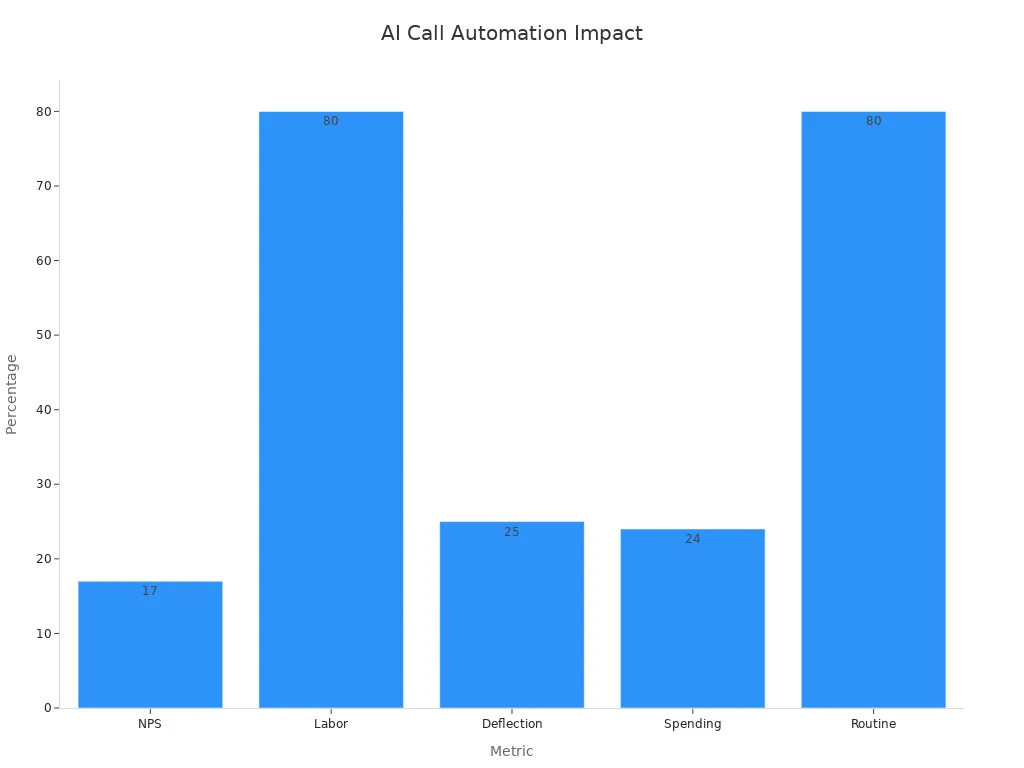
Explore how Sobot can transform your call center into a proactive, AI-powered customer service leader.
FAQ
What is call center automation?
Call center automation uses AI and ML to handle tasks like answering calls, routing, and data analysis. Companies see faster response times and better customer experience. Sobot’s platform automates routine work, helping agents focus on complex issues. Learn more.
How does AI improve customer experience in call centers?
AI provides 24/7 support, answers questions quickly, and predicts customer needs. Sobot’s AI-powered chatbots and voicebots help customers solve problems anytime. Studies show 75% of inquiries can be resolved without human help, improving satisfaction and loyalty.
Why do businesses choose Sobot for call center automation?
Businesses trust Sobot for its stable system, 99.99% uptime, and global reach. Sobot’s AI and ML tools boost efficiency and reduce costs. Companies like Agilent improved customer experience and cut costs by 25% using Sobot’s solutions.
Can Sobot’s call center automation integrate with existing systems?
Yes. Sobot’s call center automation platform integrates easily with CRM and business systems. This seamless connection helps agents access customer data and improves workflow. Integration supports better customer experience and faster service.
What are the main benefits of using ML in call center automation?
ML helps call centers learn from past interactions. It improves call routing, predicts customer needs, and personalizes service. Sobot uses ML to boost first call resolution rates and enhance customer experience, making support smarter and more efficient.
See Also
The Efficient Functioning Of Automated Call Centers
An In-Depth Look At AI Solutions For Enterprises
Comprehensive Guide To AI Software For Call Centers
